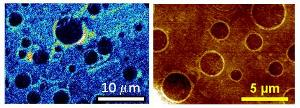Nov 5 2013
One of the most effective, yet underappreciated, human defence mechanisms relies on antimicrobial peptides - short protein fragments that identify bacteria and disrupt their membrane structure to prevent infection. This in-built defence, virtually untouched by evolution, is now giving scientists clues as to how to create better medicines to combat infection.
 Antimicrobial pores in phospholipid bilayers imaged by nanoscale secondary ion mass spectrometry (left) and atomic force microscopy (right)
Antimicrobial pores in phospholipid bilayers imaged by nanoscale secondary ion mass spectrometry (left) and atomic force microscopy (right)
There is an urgent need to find new antibiotics as bacteria are constantly evolving and steadily becoming resistant to the current arsenal used by doctors around the world. A key question is whether it is possible to create better anti-infective agents by taking a cue from nature, using design principles that link the structure of antimicrobial peptides to their formidable function. Before this can happen, we need to better understand the molecular mechanism by which these peptides do their job.
A team led by NPL, featuring scientists from the London Centre for Nanotechnology, UCL, University of Edinburgh, University of Oxford, Freie Universität Berlin and IBM, has now revealed for the first time a mechanism by which peptides rip bacterial membranes apart. Reporting in the Proceedings of the National Academy of Sciences of the USA, the team used a combination of nanoscale imaging, computer simulation and de novo protein design to make the discovery.
NPL's Paulina Rakowska, a research scientist who worked on the project, said:
"It is believed that antimicrobial peptides can be used as new therapeutics, but for us it was important to understand exact reasons for their selectivity against microorganisms and the impact they have on bacterial membranes at the molecular level."
The results uncover a dynamic process whereby peptides form tiny pores, only a few nanometres across, which subsequently expand until they eventually reach the point of complete membrane disintegration. Direct observation of these processes adds to prevailing models regarding formation of small stable pores revealing a molecular mechanism of active pore expansion.
This offers a physical basis for bacterial membrane disruption which may be useful for drug developers when designing new medicines to combat infections.